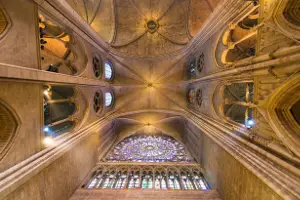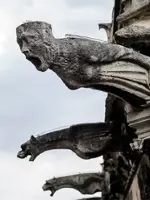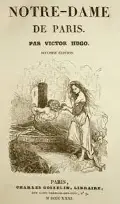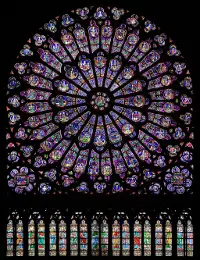|
Notre Dame Cathedral Damaged by Fire
April 15, 2019 Fire has demolished the spire of one of the world's most famous landmarks, the Notre Dame cathedral, but firefighters have saved the main structure and iconic bell towers of the 850-year-old structure. 
The cathedral, on the Ile de la Cite, one of two islands in the River Seine, in the center of the city, has been the victim of fire and smoke damage created by a fire in the attic that then spread across the roof. Firefighters numbering in the hundreds battled the blaze deep into the night and stopped the blaze from consuming the entire cathedral. The scaffolding around the building was symbolic of a $6.8 million renovation project, which had started a few years ago. Notre Dame means "our lady" or, more fully, "Our Lady of Paris." The building is the Cathedral of the Archdiocese of Paris. Annual visitors exceed 12 million people. 
The centuries-old cathedral was built at the behest of Bishop of Paris Maurice de Sully, on the site of what is believed to have been a pagan temple and then a Romanesque church known as the Basilica of Saint étienne. Construction began in 1163, with the laying of the foundation stone by Pope Alexander III and completed nearly a century later, in 1260. The choir was built first, and construction on that finished in 1177. The high altar was consecrated in 1182. The 330-foot-long roof was one of the longest in the city of Paris. Built using 5,000 oak trees, it was known for rib vaulting. Supporting the roof of the nave were a series of crossed ribs that essentially created a number of compartments. This was an architectural innovation at the time, allowing easier construction and the possibility of windows higher up on the walls. 
Another main feature of the cathedral is its famous flying buttresses (left). The 13th-Century addition of these, on the outside, meant that the walls could be higher and thinner and could have much larger windows. The result was some of the largest and most famous stained glass windows in the world, including one of the largest rose windows ever built. 
The original spire was done in the 1220s and endured for many years; however, it was removed in 1786 because of wind damage. Taking its place was a recreated spire made of oak covered with lead that together weighed 750 tons. Three holy relics were placed in the spire in 1935: one each associated with Paris patron saints Denis and St. Genevieve and a piece of the Crown of Thorns, which Christianity says Jesus wore while on the cross. The cathedral has also become known for its collection of strange creatures, including gargoyles, on the exterior. Many of the gargoyles, which act as rain spouts, have corroded and been replaced with PVC tubes. The 69-meter-tall bell towers were the highest in Paris before the construction of the Eiffel Tower, which opened in 1889.
Notre Dame was ransacked by rioting Protestant Huguenots in the 16th Century, as a religious protest. The cathedral was also savaged during the French Revolution. Designated as a symbol of the aristocracy so hated by the Revolutionaries, the cathedral found itself neglected, used as a food storage facility for a time. It was used occasionally. Secular humanists at the head of the Revolution declared the cathedral as home to the non-religious Cult of Reason and the Cult of Supreme Being. Mobs also destroyed 28 statues in what was then the Gallery of Kings; what the mob thought were French kings were actually kings from biblical times. (The heads of many of these statues were found, discarded, during a 1977 excavation and now reside in a nearby museum.)  The sacking of the cathedral at the hands of revolutionaries ended in July 1801, when Napoleon Bonaparte signed an agreement to give the cathedral back to the Catholic Church. The cathedral was the setting for Napoleon's coronation, in 1804, and of his second wedding, to Marie-Louise of Austria, in 1810. The cathedral has been the setting for many famous events:

It was the 1831 publication of Victor Hugo's book The Hunchback of Notre Dame that revived interest in the famed cathedral. The story of the bell-ringer Quasimodo fired many an imagination and sold many a copy of the well-known book. (Hugo's original title was Notre-Dame de Paris, which referred to both the cathedral itself and to Esmeralda, the main female character in the book. The English-language translation had the title that featured the cruel nickname of Quasimodo.) The popularity of the book inspired a restoration that began in 1844. The new spire was built during that 25-year restoration. The project was not financed by large sums of money, and workers used all they could afford, which meant, in some cases, low-quality stone and cement. The building has become known in recent years for stray bits of stone falling off. More recently, stray bullets fired during the liberation of Paris from Germany during World War II caused some damage inside the cathedral. A beehive atop the sacristy was added in 2013. As for the famous bells, the heaviest of the 10 weighs 13 tons. They were replaced in 2012 to mark the 850th birthday of the cathedral. |
|
Social Studies for Kids
copyright 2002–2024
David White



 The cathedral was cleaned in 1963 and, once hundreds of years of grime and soot had been removed, restored to its original off-white color. Further cleaning and restoration occurred from 1991 to 2000.
The cathedral was cleaned in 1963 and, once hundreds of years of grime and soot had been removed, restored to its original off-white color. Further cleaning and restoration occurred from 1991 to 2000.


